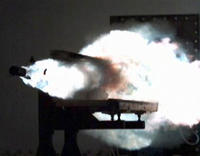-
Growing use of IEDs by anti-government insurgents in Syria
The monthly number of IEDs reported in Syria jumped 134 percent from December to January; analysts say this is an indication of foreign involvement with the rebels
-
-
U.S. Navy tests electromagnetic railgun launcher

The electromagnetic railgun launcher is a long-range weapon that fires projectiles using electricity instead of chemical propellants; magnetic fields created by high electrical currents accelerate a sliding metal conductor, or armature, between two rails to launch projectiles at 4,500 mph to 5,600 mph; the new railgun will allow the U.S. Navy to conduct precise, long-range naval surface fire support for land strikes, ship self-defense against cruise and ballistic missiles, and surface warfare to deter enemy vessels
-
-
Detecting explosives from a distance with laser beams
Scientists have found a way to detect chemicals over long distances, even if they are enclosed in containers; the scientists tested the system by trying to detect frequently used explosives, such as TNT, ANFO, or RDX from a distance – and the tests were successful
-
-
Rats trained to detect explosives
Bomb sniffing dogs could be a thing of the past thanks to explosives seeking rats; unlike dogs, when rats detect sensitive explosives like land mines they rarely set them off as they weigh less than pound
-
-
SOUTHCOM deploys radar that sees through foliage, rain, darkness, and dust storms
Lockheed Martin’s TRACER is a light weight, low-frequency synthetic-aperture radar that can peer through foliage, rain, darkness, dust storms, or atmospheric haze to provide real-time, high-quality tactical ground imagery; U.S. Southern Command has just deployed the penetrating radar to support the Command’s counter-terrorism and humanitarian assistance missions, and disaster relief operations
-
-
End of Utah’s chemical weapons stockpile signals end of federal grants

As the last of Utah’s chemical weapons stockpile is destroyed, the millions of dollars that have flowed into the state from federal grants will begin to disappear along with thousands of jobs
-
-
One in three of military aircraft are drones
A report by the Congressional Research Service (CRS) recently made public reveals that unmanned drones now account for 31 percent of all military aircraft
-
-
In Keene, N.H., locals oppose military equipment for police
With the help of a $285,933 DHS grant, local police in Keene, New Hampshire were all set to purchase a new armored vehicle until local residents got wind of the plan; the citizens of the quiet New Hampshire town of 23,000, which has only seen two murders since 1999, questioned why police needed such an expensive military-type truck and balked at the militarization of a local force; with federal counterterrorism money continuing to pour into local communities, lawmakers and residents across the country will have to grapple with the same issues as Keene and determine what kind of police force they want to have patrolling the streets
-
-
Advanced forensic tool for the battlefield
A forensic tool could soon make the analysis of evidence faster and more accurate, giving military investigators an advantage in the wars against drugs and terror
-
-
Four-legged robot carries troops’ load
The increasing weight of military equipment has a negative impact on soldiers’ readiness and effectiveness; reducing the load on dismounted soldiers has thus become a major point of emphasis for defense research and development; the Legged Squad Support System (LS3) robot follows squad members through rugged terrain and interact with them in a natural way, similar to the way a trained animal and its handler interact, while carrying 400 lbs. of squad’s gear
-
-
U.S. Navy’s railgun takes an important step forward
In the coming weeks the first industry railgun prototype launcher will be tested at a U.S. Navy facility in Virginia; the railgun launcher is a long-range weapon that fires projectiles using electricity instead of chemical propellants
-
-
New missile defense developed for Royal Navy
As tension in and around the Persian Gulf and the Straits of Hormuz increase, the U.K. government has confirmed the development of a new Royal Navy missile defense system which will be able to intercept and destroy enemy missiles travelling at supersonic speeds
-
-
Helicopters emulate humpback whales to become more maneuverable
Humpback whales are renowned for their great speed and acrobatic skills; they achieve both because of their unusually large pectoral fins, which have characteristic bumps along the front edge; researcher say that placing similar bumps on helicopter rotor blades (the technical term is “leading-edge vortex generators”) will increase the speed and maneuverability of helicopters
-
-
Self-guided bullet can hit target a mile away
Researchers have designed a self-guided bullet; the dart-like, self-guided bullet for small-caliber, smooth-bore firearms that hit laser-designated targets at distances of more than a mile
-
-
Army wants IED detecting paintball gun
The U.S. Army is currently exploring how to turn an ordinary paintball gun into an explosive detecting tool; the Army hopes to create a gun that can shoot specially designed projectiles at a suspected improvised explosive device (IED) to determine if it is an explosive or not
-
More headlines
The long view
Bookshelf: Smartphones Shape War in Hyperconnected World
By Kathryn Brimblecombe-Fox
The smartphone is helping to shape the conduct and representation of contemporary war. A new book argues that as an operative device, the smartphone is now “being used as a central weapon of war.”
